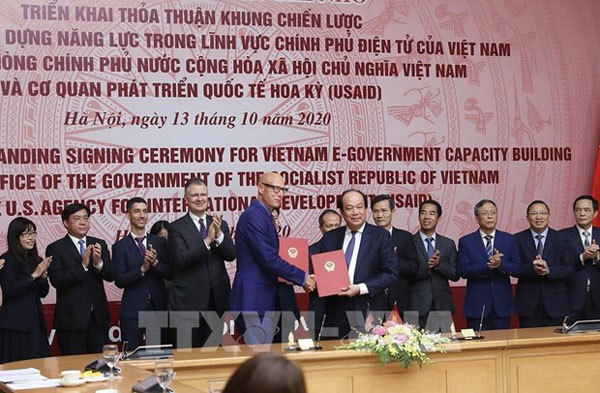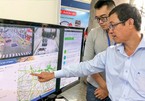 |
| USAID helps Vietnam strengthen e-Government capacity. (Illustrative image. – Photo: VNA) |
The process of investment relocation may take time but Vietnam has been active to grasp opportunities resulted from such strategic shift.
Successful containment of COVID-19
The world’s news outlets have praised Vietnam’s capacity to contain the pandemic which is still evolving swiftly around the globe, allowing the Southeast Asian country to re-emerge quickly and become one of the best performers in the global economy.
As current ASEAN Chair, Vietnam has actively activated virtual channels to ensure continuous communication among ASEAN member and this solution also helped ASEAN and its partners to stay connected during this crisis, sustain seamless coordination, and make quick and timely responses.
As all COVID-19 hot spots have been brought under control, the Government decided to resume international commercial flights to Guangzhou (China), Taiwan (China), Seoul (the Republic of Korea), and Tokyo (Japan) from September 15, and to Phnom Penh (Cambodia) and Vientiane (Laos) from September 22, to bring foreign investors and skilled workers to Vietnam.
Government’s determination
Last June, Prime Minister Nguyen Xuan Phuc set up a working group which is responsible for promoting foreign investment cooperation amid strategic shift of supply chains.
The working group, led by Deputy Prime Minister, Foreign Minister Pham Binh Minh, is tasked to formulate new policies to catch investment capital inflows early from multinational groups which are repositioning manufacturing facilities after the COVID-19 pandemic.
The Government is also extensively investing in major transport projects to further improve connectivity, which include the North-South Expressway and Long Thanh International Airport.
By offering investment opportunities, Vietnam has long been recognized as a hub for foreign investment. Last year, the United States News and World Report ranked Vietnam 8th in a list of 29 best economies to invest in.
The next closest ASEAN countries on the list were Malaysia (13th), Singapore (14) and Indonesia (18th).
Positive economic signs in Jan-Sep period
Vietnam’s GDP expanded 2.12% in the first nine months this year despite the emergence of the second wave of COVID-19 in late July, making it the only economy in ASEAN to have attained positive growth.
Exports still maintained growth momentum, increasing by 15% against the same period last year, in which domestic economic sector’s exports rose by 20.2%.
Though foreign investment inflows experienced a year-on-year decline of 18.9% in the reviewed period, the pledged volume was quite positive, with US$21.2 billion.
The World Bank forecasts that Vietnam’s GDP could reach 2.8% in 2020 and 6.7% next year while Prime Minister Nguyen Xuan Phuc urged subordinate levels to strive for growth rate of 2.5-3% this year.
Better indicators
First introduced in 2017 in the Government’s Resolution on major solutions to improve business climate, the Cabinet has used the Global Innovation Index (GII) as an important administration and management tool.
Along with three other developing countries, namely China, India and the Philippines, Vietnam has made the most impressive progress in terms of the GII rankings, currently placed 42nd out of 131 economies, up 17 spots since 2016.
Commenting on Vietnam’s efforts, General Director of the World Intellectual Property Organization (WIPO) Francis Gurry highlighted Viet Nam is among the group of lower middle-income countries with their GII 2020 going beyond their development level.
Business environment indicators have also improved constantly as evidenced by increasingly better global rankings.
Specifically, Vietnam ranked 67th out of 141 countries in the World Economic Forum’s Global Competitiveness Report, up 10 places compared to 2018.
The World Bank ranked Vietnam 70th out of 190 economies based on two main factors: improved access to credit information through data distribution from retailers and upgraded information technology infrastructure that make paying taxes easier for most businesses.
In terms of tourism, the Southeast Asian country jumped to 63rd among 140 countries and territories in the Travel & Tourism Competitiveness Index (TTCI) 2019, up four places compared to 2017 and 12 places against 2015.
On logistics, Vietnam’s position on the Logistics Performance Index (LPI) in 2018 has jumped 25 places compared to two years ago, to 39th among 160 surveyed countries, according to the World Bank.
For cybersecurity index, the country recorded impressive improvements, standing 50th on the Global Cybersecurity Index (CGI) rankings in 2018, up 50 places from a year earlier.
With a score of 0.693, Vietnam ranked 11th in the Asia-Pacific region, which was topped by Singapore, Malaysia and Australia.
The United States (US) News and World Report last month ranked Vietnam eighth in a list of 29 best economies to invest in, and the next closest ASEAN countries on the list were Malaysia (13th), Singapore (14th) and Indonesia (18th).
FTA network
Alongside domestic reforms, Vietnam has taken steps toward trade liberalization and international economic integration into the global economy.
Up to now, Vietnam has signed 13 free trade agreements and joined negotiations on three others, with the regional comprehensive economic partnership expected to be signed by this year’s end.
The country’s embarkation on trade liberation has led to increased trade flows and foreign investment inflows.
More reforms needed
Former World Bank Country Director in Vietnam Ousmane Dione suggested it is necessary for Vietnam to change the mindset, motivation, aspiration and determination to make a change, and create breakthroughs in the use of high technology and digital technology for global integration.
The earlier reform seems to have reached its limits. In order for Vietnam to make the next jump, it is required to have a new reform to break the glass ceiling, a reform to overcome current challenges or also called "Doi Moi 4.0", which leans more towards quality.
In order to do that, Vietnam needs to pay attention to a number of issues. First, state management needs to improve. It is necessary to improve innovation for the government system, which needs to take advantage of digital strengths.
Second, planning and capacity building needs to be strengthened, to make sure implementing agencies can develop and effectively implement policy.
The third issue is reporting and accountability mechanism. Vietnam needs more accurate, effective, transparent and timely analysis to assist with faster, more timely and more impactful decision making.
Vietnam needs to promote economic diplomacy to pave the way for businesses to expand their operation globally, to access new technologies and create new resources. For example, although Vietnam is currently the country that attracts the most foreign direct investment (FDI), Vietnam still experiences challenges in connecting foreign-invested enterprises with domestic private sector, lacking connectivity and value added.
Thanks to Vietnam’s active participation in free trade agreements, many Vietnamese enterprises are now reaching out to the world, but the majority have not yet taken the advantage to connect with the foreign investment sector to reach out. It is encouraging that when joining a bigger playground, Vietnam has a very good motivation to raise its own standards.
The Southeast Asian country should strengthen and mobilize many resources such as private capital, highly skilled human resources, innovation and infrastructure to grow fast and ensure sustainability, protect the environment, reduce emissions, deal with water pollution, landslides, protect resources, according to Ousmane Dione. VGP
Quang Minh

Stepping towards the future of e-governing
The Vietnamese government is trying to build up an effective e-government to bring more benefits to both public and enterprises.

E-government growth to closely connect with smart city, digital transformation
The Ministry of Information and Communications (MIC) has just held a consultation session with businesses about proper strategies for e-government development in the period from 2021 – 2025, with a vision to 2030.